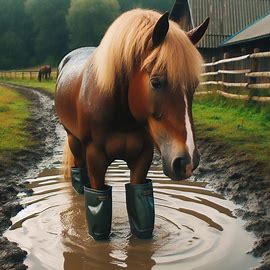
Title: Strategies for Maintaining Healthy Hooves in Damp Conditions
As the spring season rolls in, so does the challenge of maintaining healthy hooves, especially in areas where dampness prevails. Damp and wet conditions can wreak havoc on the structure of hooves, making them susceptible to various ailments like thrush, white line disease, and abscesses. However, with effective strategies, farriers can help horse owners combat these prevalent springtime concerns and ensure the well-being of their equine companions.
Understanding the Impact of Dampness on Hooves:
Hooves are remarkably adaptable structures designed to withstand a range of environmental conditions. However, consistent exposure to damp and wet environments can compromise their integrity. Here’s how:
- Thrush: Thrush is a bacterial infection that thrives in moist, anaerobic environments. Damp hooves provide the perfect breeding ground for the bacteria responsible for thrush, leading to foul-smelling discharge, blackening of the hoof tissue, and eventual deterioration of the frog.
- White Line Disease: White line disease occurs when moisture penetrates the hoof wall, leading to the separation of the inner hoof structures. In damp conditions, the hoof wall becomes softer and more prone to invasion by bacteria and fungi, resulting in white, powdery lines along the hoof wall and potential lameness if left untreated.
- Abscesses: Prolonged exposure to moisture can soften the hoof and make it more susceptible to bruising and injury. This increases the likelihood of bacterial invasion, leading to the formation of abscesses, which manifest as localized pockets of pus within the hoof.
Effective Strategies for Prevention and Treatment:
- Proper Hoof Care Routine: Establishing a consistent hoof care routine is paramount in damp conditions. Regular cleaning and inspection of hooves allow farriers to identify early signs of thrush, white line disease, or abscesses. Use a hoof pick to remove dirt, debris, and accumulated mud from the hoof’s crevices.
- Maintain Dry Bedding: Ensure that the horse’s living environment, including stalls and turnout areas, remains as dry as possible. Use absorbent bedding materials such as shavings or straw to minimize moisture accumulation. Regularly muck out stalls and replace wet bedding to prevent prolonged contact with dampness.
- Appropriate Trimming and Shoeing: Proper trimming and shoeing play a crucial role in hoof health, especially in damp conditions. Farriers should trim hooves to maintain an optimal balance and remove any compromised or overgrown areas. Consider using hoof supplements or topical treatments recommended by veterinarians to strengthen the hoof structure.
- Application of Hoof Sealants: Hoof sealants can provide an additional layer of protection against moisture infiltration. Apply a quality hoof sealant to the hoof wall and sole, paying particular attention to the frog and white line areas. This helps to create a barrier that prevents bacteria and fungi from thriving in damp conditions.
- Dry Off Periods: Allow horses to dry off naturally after exposure to damp conditions, especially after bathing or riding in wet terrain. Avoid prolonged turnout on wet grass or muddy paddocks, as this can exacerbate moisture-related hoof issues.
- Consultation with a Veterinarian: In cases where thrush, white line disease, or abscesses have already developed, prompt veterinary intervention is essential. Veterinarians can provide specialized treatment options, including topical medications, antimicrobial hoof soaks, or therapeutic shoeing techniques, to address specific hoof ailments.
Conclusion:
Maintaining healthy hooves in damp conditions requires a proactive approach involving regular hoof care, environmental management, and collaboration between farriers and veterinarians. By implementing effective strategies for prevention and treatment, horse owners can safeguard their equine companions against common springtime concerns such as thrush, white line disease, and abscesses. Remember, prevention is key, but timely intervention can also mitigate the impact of dampness on hoof health.
Shop for hoof care products here
.


Recent Comments